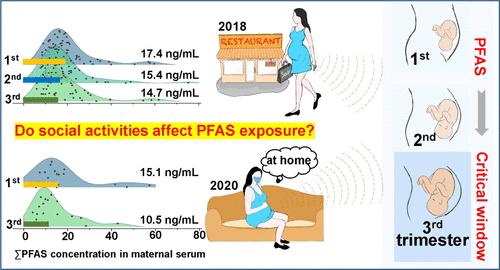当前位置:
X-MOL 学术
›
Environ. Sci. Technol.
›
论文详情
Our official English website, www.x-mol.net, welcomes your
feedback! (Note: you will need to create a separate account there.)
Prenatal Exposure of PFAS in Cohorts of Pregnant Women: Identifying the Critical Windows of Vulnerability and Health Implications
Environmental Science & Technology ( IF 10.8 ) Pub Date : 2024-07-25 , DOI: 10.1021/acs.est.4c00453 Yadan Luo 1, 2, 3 , Xiaona Li 4 , Juan Li 1 , Xiaoli Gong 4 , Tianchen Wu 4 , Xuening Li 4 , Zhao Li 1 , Yujia Zhai 4 , Yuan Wei 4 , Yawei Wang 1, 5 , Guibin Jiang 1
Environmental Science & Technology ( IF 10.8 ) Pub Date : 2024-07-25 , DOI: 10.1021/acs.est.4c00453 Yadan Luo 1, 2, 3 , Xiaona Li 4 , Juan Li 1 , Xiaoli Gong 4 , Tianchen Wu 4 , Xuening Li 4 , Zhao Li 1 , Yujia Zhai 4 , Yuan Wei 4 , Yawei Wang 1, 5 , Guibin Jiang 1
Affiliation

|
Cohorts of pregnant women in 2018 and 2020 were selected to explore prenatal exposure to perfluoroalkyl and polyfluoroalkyl substances (PFAS). Maternal serum during the whole pregnancy (first to third trimesters) and matched cord serum were collected for the analysis of 50 PFAS. Perfluorooctanoic acid (PFOA), perfluorooctanesulfonic acid (PFOS), and 6:2 fluorotelomer sulfonic acid (6:2 FTS) were the dominant PFAS in both the maternal and cord serum. The median ∑PFAS concentration was 14.18 ng/mL, and the ∑PFAS concentration was observed to decline from the first trimester to the third trimester. The transplacental transfer efficiencies (TTE) of 29 PFAS were comprehensively assessed, and a “U”-shaped trend in TTE values with increasing molecular chain length of perfluoroalkyl carboxylic acid (PFCA) was observed in this study. Moreover, the maternal concentrations of 9-chlorohexadecafluoro-3-oxanonane-1-sulfonic acid (6:2 Cl-PFESA), perfluorononanoic acid (PFNA), perfluorodecanoic acid (PFDA), perfluoroundecanoic acid (PFUdA), perfluorododecanoic acid (PFDoA), PFOS, and hexafluoropropylene oxide dimer acid (HFPO–DA) in the 2020 cohort were significantly lower than those in the 2018 cohort, declining by about 23.85–43.2% from 2018 to 2020 (p < 0.05). Higher proportions of emerging PFAS were observed in fetuses born in 2020. This birth cohort was collected during the COVID-19 epidemic period. The change in the PFAS exposure scene might be in response to the different exposure profiles of the 2018 and 2020 cohorts, which are attributed to the impact of COVID-19 on the social activities and environment of pregnant women. Finally, by application of a multiple informant model, the third trimester was identified as the critical window of vulnerability to PFAS exposure that affects birth weight and birth length.
中文翻译:

孕妇群体的产前 PFAS 暴露:确定脆弱性和健康影响的关键窗口
选择 2018 年和 2020 年孕妇队列来探讨全氟烷基和多氟烷基物质 (PFAS) 的产前暴露情况。收集整个妊娠期间(妊娠早期至妊娠晚期)的母体血清和匹配的脐带血清,用于分析 50 种 PFAS。全氟辛酸 (PFOA)、全氟辛烷磺酸 (PFOS) 和 6:2 氟调聚物磺酸 (6:2 FTS) 是母体血清和脐带血清中的主要 PFAS。 ΣPFAS 浓度中位数为 14.18 ng/mL,观察到 ΣPFAS 浓度从妊娠早期到妊娠晚期有所下降。综合评估了29种PFAS的经胎盘转移效率(TTE),本研究观察到TTE值随着全氟烷基羧酸(PFCA)分子链长度的增加呈“U”形趋势。此外,9-氯十六氟-3-氧杂壬烷-1-磺酸 (6:2 Cl-PFESA)、全氟壬酸 (PFNA)、全氟癸酸 (PFDA)、全氟十一烷酸 (PFUdA)、全氟十二烷酸 (PFDoA) 的母体浓度2020 年队列中的全氟辛烷磺酸 (PFOS) 和六氟环氧丙烷二聚酸 (HFPO-DA) 显着低于 2018 年队列,从 2018 年到 2020 年下降了约 23.85-43.2% ( p < 0.05)。在 2020 年出生的胎儿中观察到新出现 PFAS 的比例较高。该出生队列是在 COVID-19 流行期间收集的。 PFAS暴露场景的变化可能是对2018年和2020年队列不同暴露情况的反应,这归因于COVID-19对孕妇社会活动和环境的影响。 最后,通过应用多线模型,妊娠晚期被确定为易受 PFAS 暴露影响的关键窗口,影响出生体重和出生身长。
更新日期:2024-07-25
中文翻译:

孕妇群体的产前 PFAS 暴露:确定脆弱性和健康影响的关键窗口
选择 2018 年和 2020 年孕妇队列来探讨全氟烷基和多氟烷基物质 (PFAS) 的产前暴露情况。收集整个妊娠期间(妊娠早期至妊娠晚期)的母体血清和匹配的脐带血清,用于分析 50 种 PFAS。全氟辛酸 (PFOA)、全氟辛烷磺酸 (PFOS) 和 6:2 氟调聚物磺酸 (6:2 FTS) 是母体血清和脐带血清中的主要 PFAS。 ΣPFAS 浓度中位数为 14.18 ng/mL,观察到 ΣPFAS 浓度从妊娠早期到妊娠晚期有所下降。综合评估了29种PFAS的经胎盘转移效率(TTE),本研究观察到TTE值随着全氟烷基羧酸(PFCA)分子链长度的增加呈“U”形趋势。此外,9-氯十六氟-3-氧杂壬烷-1-磺酸 (6:2 Cl-PFESA)、全氟壬酸 (PFNA)、全氟癸酸 (PFDA)、全氟十一烷酸 (PFUdA)、全氟十二烷酸 (PFDoA) 的母体浓度2020 年队列中的全氟辛烷磺酸 (PFOS) 和六氟环氧丙烷二聚酸 (HFPO-DA) 显着低于 2018 年队列,从 2018 年到 2020 年下降了约 23.85-43.2% ( p < 0.05)。在 2020 年出生的胎儿中观察到新出现 PFAS 的比例较高。该出生队列是在 COVID-19 流行期间收集的。 PFAS暴露场景的变化可能是对2018年和2020年队列不同暴露情况的反应,这归因于COVID-19对孕妇社会活动和环境的影响。 最后,通过应用多线模型,妊娠晚期被确定为易受 PFAS 暴露影响的关键窗口,影响出生体重和出生身长。











































 京公网安备 11010802027423号
京公网安备 11010802027423号